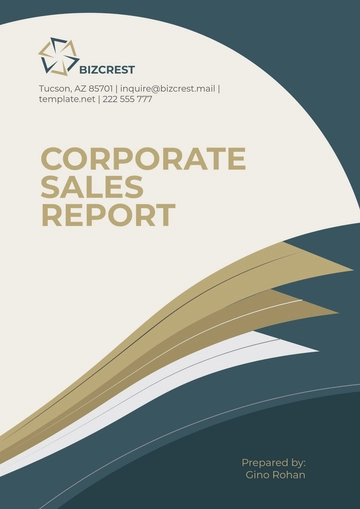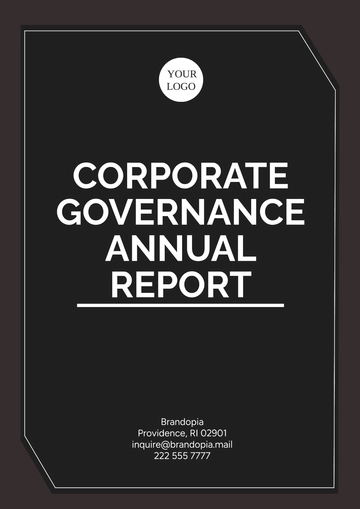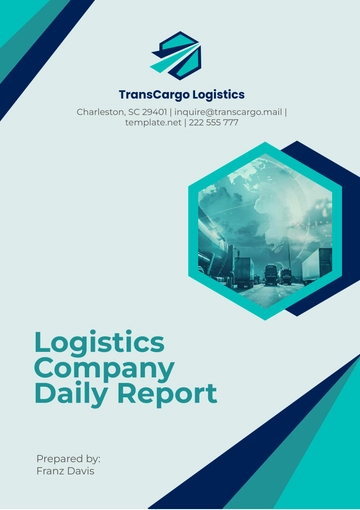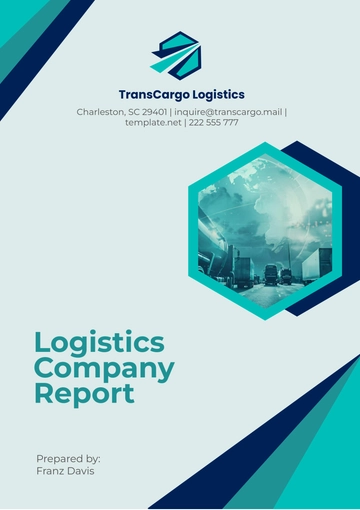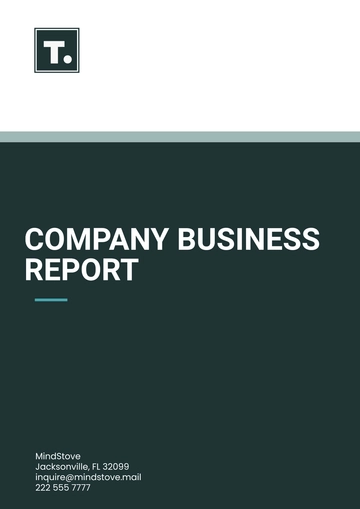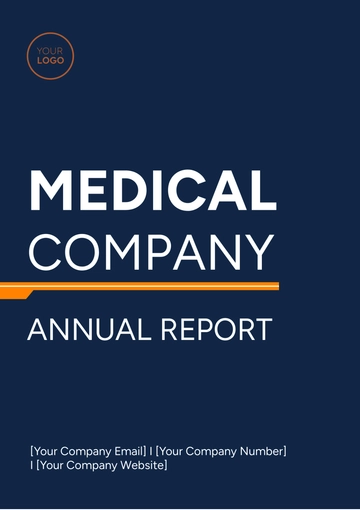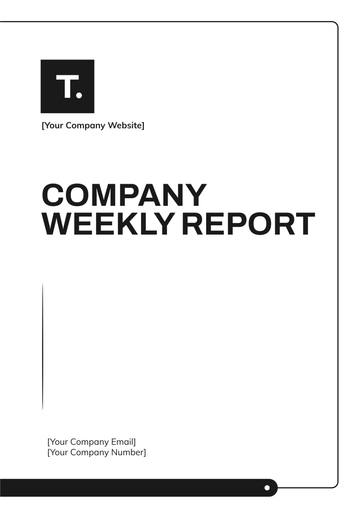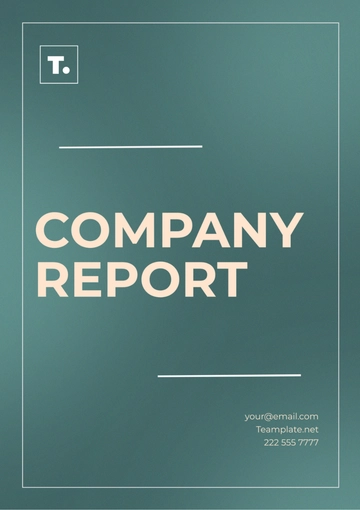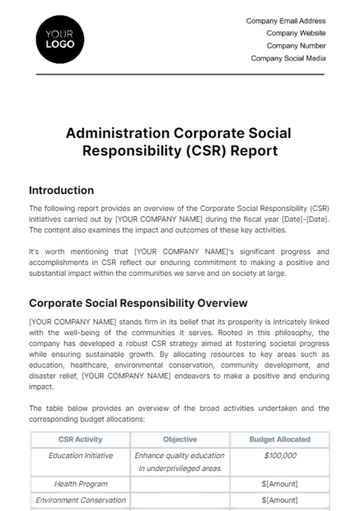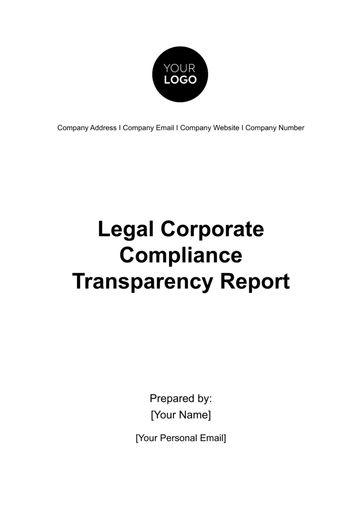Free Logistics Company Report
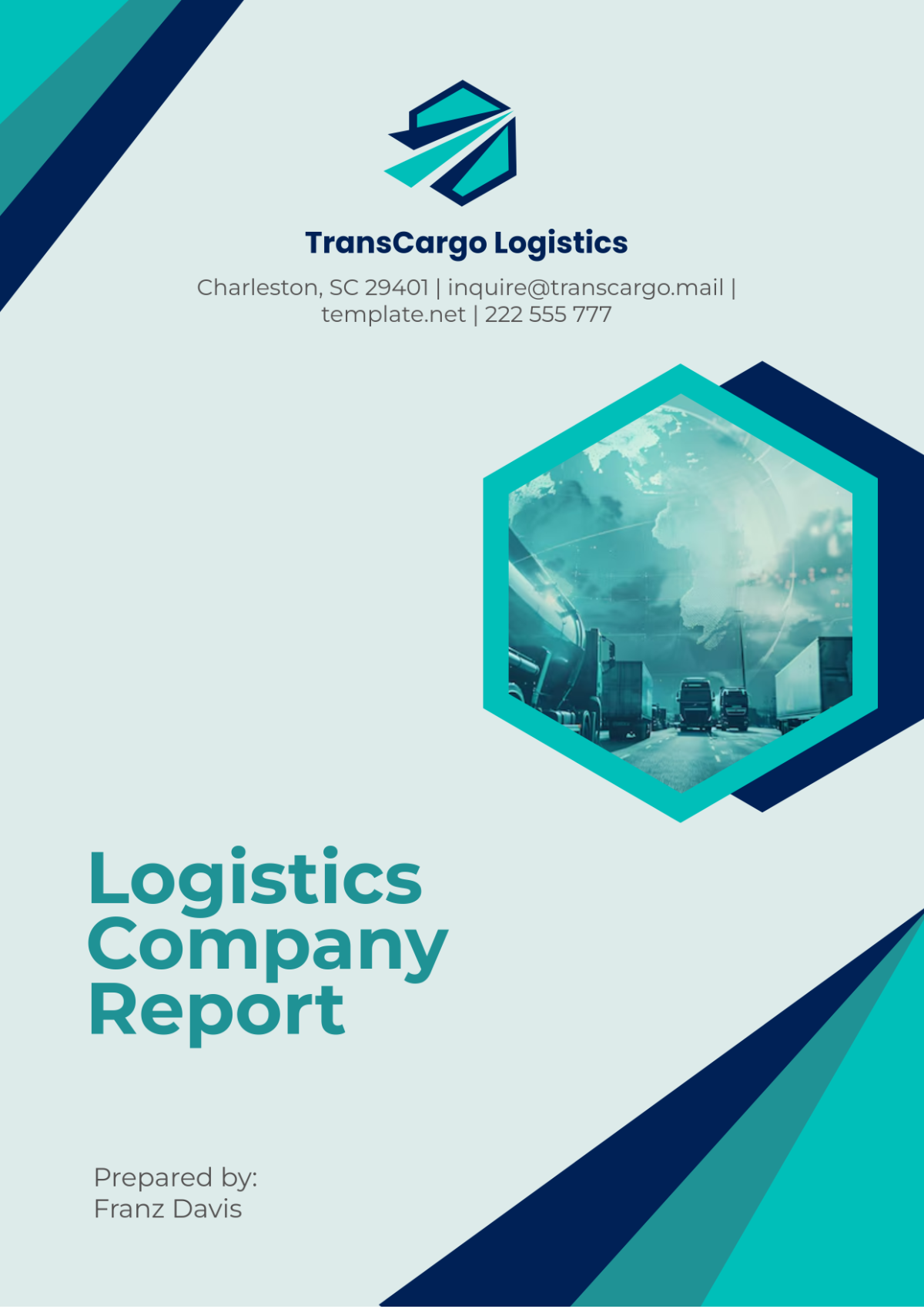
1. Executive Summary
In [2050], [Your Company Name] achieved remarkable growth and innovation in the logistics sector. This report provides a comprehensive overview of our operational performance, challenges faced, and strategic recommendations for the future. By focusing on sustainability, technology integration, and talent development, we have positioned ourselves as a leader in the logistics industry. Our efforts have not only contributed to our bottom line but also significantly enhanced customer satisfaction and loyalty.
Throughout this report, we will explore the various facets of our operations, including financial performance, operational efficiency, sustainability initiatives, and workforce development. Our goal is to provide stakeholders with a transparent view of how [Your Company Name] is navigating the complexities of the modern logistics landscape while staying committed to our core values.
2. Company Overview
2.1 Mission Statement
Our mission is to deliver efficient and sustainable logistics solutions that meet the evolving needs of our customers while promoting environmental stewardship and community well-being. We understand that our role goes beyond simply moving goods; we aim to make a positive impact on the communities we serve and the planet we inhabit.
2.2 Vision Statement
We envision a future where logistics are seamless, sustainable, and integrated with cutting-edge technology, making global commerce accessible to all. Our vision includes leveraging advanced technologies that facilitate smarter logistics networks, resulting in improved service delivery and reduced environmental impact.
2.3 Core Values
Integrity: We adhere to the highest ethical standards in all our operations, ensuring that our practices reflect honesty and transparency. This commitment fosters trust among our clients, partners, and employees.
Innovation: We embrace change and continually seek new solutions, understanding that innovation is vital to staying competitive in the logistics industry. This value drives us to invest in research and development, allowing us to adapt quickly to market shifts.
Sustainability: We are committed to reducing our environmental impact through initiatives that promote sustainable practices. This includes optimizing our transportation routes to decrease fuel consumption and using eco-friendly materials in our packaging.
Customer Focus: We prioritize the needs and satisfaction of our customers by providing tailored solutions that address their unique challenges. Regular feedback loops with clients help us understand their evolving requirements, enabling us to adapt our services accordingly.
3. Industry Landscape
3.1 Current Trends in Logistics
The logistics industry in [2050] is characterized by several key trends:
Technological Integration: The adoption of AI and IoT is revolutionizing supply chain management, enabling real-time tracking and automated processes. These technologies help us streamline operations and improve accuracy in order fulfillment.
Sustainability Initiatives: Companies are increasingly focusing on eco-friendly practices, such as electric vehicles and green warehouses, to reduce carbon footprints. [Your Company Name] has actively participated in industry-wide initiatives aimed at minimizing waste and promoting circular economy principles.
E-commerce Growth: The rise of online shopping has intensified demand for rapid and efficient logistics services. As consumers expect quicker deliveries, our strategies have evolved to accommodate same-day and next-day delivery options, ensuring we meet customer expectations.
3.2 Competitive Analysis
Our analysis of the competitive landscape reveals that [Your Company Name] holds a [20%] market share in the logistics sector. The table below outlines our main competitors and their market shares, highlighting the competitive dynamics of the industry:
Competitor | Market Share (%) |
|---|---|
[Competitor A] | [25%] |
[Competitor B] | [20%] |
[Your Company Name] | [20%] |
[Competitor C] | [15%] |
[Competitor D] | [10%] |
Others | [10%] |
Our market position reflects our commitment to quality service and customer satisfaction. However, we recognize the need for continual improvement to maintain and grow our market share amidst rising competition.
4. Financial Performance
4.1 Revenue Growth
In [2050], [Your Company Name] reported a significant increase in revenue, with total revenue reaching [$500 million]. This growth can be attributed to strategic investments in technology and an expanding customer base. The table below illustrates our revenue growth over the past five years, showcasing a consistent upward trend:
Year | Revenue ($ Million) | Year-over-Year Growth (%) |
|---|---|---|
[2050] | [350] | - |
[2051] | [370] | [5.71%] |
[2052] | [400] | [8.11%] |
[2053] | [450] | [12.50%] |
[2054] | [500] | [11.11%] |
This revenue trajectory reflects our ability to adapt to market demands and seize growth opportunities in a competitive landscape.
4.2 Profitability Metrics
Our profitability has also improved, as shown in the table below, which highlights our net profit over the same period:
Year | Net Profit ($ Million) | Profit Margin (%) |
|---|---|---|
[2050] | [50] | [14.29%] |
[2051] | [55] | [14.86%] |
[2052] | [60] | [15.00%] |
[2053] | [65] | [14.44%] |
[2054] | [75] | [15.00%] |
The improvement in our profit margins indicates that we are not only growing but also managing our costs effectively. This balance is crucial for sustaining our operations and funding future initiatives.
5. Operational Performance
5.1 Fleet and Transportation
Our fleet has expanded significantly, incorporating more fuel-efficient and electric vehicles to align with our sustainability goals. The table below summarizes our fleet performance, showcasing our commitment to modernizing our transportation network:
Year | Total Fleet Size | Electric Vehicles (%) | Average Delivery Time (Days) |
|---|---|---|---|
[2050] | [500] | [10%] | [5] |
[2051] | [550] | [15%] | [4.8] |
[2052] | [600] | [20%] | [4.5] |
[2053] | [650] | [25%] | [4.2] |
[2054] | [700] | [30%] | [4] |
By continuously upgrading our fleet, we enhance our ability to deliver goods efficiently while reducing our environmental impact. This strategic approach not only satisfies customer demands for faster service but also aligns with our sustainability objectives.
5.2 Warehouse Operations
In [2050], our warehouse operations have also seen improvements in efficiency due to automation and better inventory management. The following table summarizes our warehouse performance:
Year | Total Warehouse Space (sq ft) | Warehouse Automation (%) | Inventory Turnover Ratio |
|---|---|---|---|
[2050] | [1,000,000] | [20%] | [6.0] |
[2051] | [1,200,000] | [30%] | [6.5] |
[2052] | [1,500,000] | [40%] | [7.0] |
[2053] | [1,800,000] | [50%] | [7.5] |
[2054] | [2,000,000] | [60%] | [8.0] |
The increase in warehouse automation has significantly improved our processing speed and accuracy. As we enhance our inventory turnover ratio, we can better meet customer demands while minimizing holding costs.
5.3 Technology Implementation
The implementation of advanced technologies has improved operational efficiency across various sectors. The table below outlines the technologies we've adopted and their impact:
Technology | Implementation Year | Efficiency Improvement (%) |
|---|---|---|
AI-Powered Route Optimization | [2050] | [15%] |
IoT Tracking Systems | [2051] | [20%] |
Warehouse Robotics | [2052] | [25%] |
Blockchain for Inventory | [2053] | [30%] |
These technologies have revolutionized our logistics processes, enabling us to streamline operations, enhance customer visibility, and improve supply chain resilience.
6. Sustainability Initiatives
6.1 Environmental Goals
In [2050], [Your Company Name] committed to ambitious environmental goals, including a reduction of greenhouse gas emissions by [30%] compared to [2040] levels. The following table outlines our sustainability achievements and ongoing initiatives:
Initiative | Target Year | Progress (%) |
|---|---|---|
Transition to Electric Fleet | [2055] | [40%] |
Carbon Neutral Warehouses | [2050] | [60%] |
Waste Reduction Programs | [2052] | [50%] |
Renewable Energy Usage | [2055] | [35%] |
Our commitment to sustainability not only addresses environmental concerns but also aligns with consumer preferences for eco-friendly practices, thereby enhancing our brand reputation.
6.2 Community Engagement
We have launched several community engagement initiatives, including partnerships with local organizations to promote sustainability awareness. These programs aim to educate the public about reducing waste and using sustainable transportation. Our community efforts also include donating resources and support to local businesses, reinforcing our commitment to social responsibility.
7. Customer Satisfaction
7.1 Customer Feedback and Reviews
In 2050, we conducted a customer satisfaction survey to gather feedback on our services. The results are summarized in the table below:
Satisfaction Metric | Rating (Out of 5) | Customer Comments |
|---|---|---|
Overall Satisfaction | [4.5] | "Excellent service and support!" |
Timeliness of Deliveries | [4.7] | "Always on time!" |
Communication | [4.3] | "Responsive and helpful." |
Value for Money | [4.6] | "Great value for high quality." |
7.2 Customer Retention Rates
Our customer retention rate has improved significantly:
Year | Retention Rate (%) | Year-over-Year Change (%) |
|---|---|---|
[2050] | [70%] | - |
[2051] | [72%] | [2.86%] |
[2052] | [75%] | [4.17%] |
[2053] | [78%] | [4.00%] |
[2054] | [80%] | [2.56%] |
8. Challenges and Risk Management
8.1 Supply Chain Disruptions
The logistics industry faced significant challenges in 2050 due to supply chain disruptions caused by geopolitical tensions, natural disasters, and fluctuating economic conditions. Our strategy to address these disruptions involved diversifying our supplier base and establishing contingency plans for critical materials. By developing relationships with multiple suppliers across different regions, we reduced the risk of shortages and improved our responsiveness to unexpected challenges. Additionally, we have invested in advanced forecasting tools that allow us to predict potential disruptions and adjust our logistics strategies accordingly.
8.2 Regulatory Compliance
Navigating the complex regulatory landscape remained a priority for [Your Company Name]. In 2050, we strengthened our compliance team to ensure adherence to international regulations regarding transportation, trade, and environmental standards. We conducted regular training sessions for our employees, fostering a culture of compliance and accountability. Our proactive approach helped us avoid costly fines and maintained our reputation as a responsible logistics provider.
8.3 Cybersecurity Threats
With the increasing reliance on technology, cybersecurity threats have emerged as a significant risk. In 2050, we implemented advanced cybersecurity measures, including multi-factor authentication, encryption protocols, and continuous monitoring systems. Our investment in cybersecurity not only protected sensitive data but also ensured the integrity of our operational systems. We conducted regular cybersecurity audits and employee training to enhance awareness and preparedness, fostering a secure environment for our digital operations.
8.4 Economic Volatility
Economic fluctuations, including inflation and currency exchange rate instability, posed challenges to our profit margins and operational costs. To mitigate these risks, we employed hedging strategies to protect against adverse currency movements and established flexible pricing models that allowed us to adjust to changing economic conditions. Our focus on maintaining strong relationships with key financial institutions enabled us to access necessary liquidity during periods of economic uncertainty, ensuring our operational continuity.
9. Human Resources and Talent Development
9.1 Workforce Expansion and Skills Training
In 2050, [Your Company Name] expanded its workforce by [10%] to accommodate our growing operations. Recognizing that our employees are our greatest asset, we invested in comprehensive training programs aimed at enhancing skills across all levels of the organization. We emphasized technical training in logistics management systems, safety protocols, and sustainability practices, empowering our workforce to adapt to the evolving demands of the industry. Our focus on skill development not only improved employee performance but also fostered loyalty and retention.
9.2 Employee Engagement and Retention Strategies
Employee engagement initiatives were key in maintaining a motivated workforce. In 2050, we implemented regular feedback mechanisms and employee recognition programs to celebrate individual and team achievements. Our comprehensive wellness programs, which include mental health support and flexible working arrangements, contributed to higher employee satisfaction rates. By prioritizing a positive workplace culture, we reduced turnover rates by [15%], ensuring stability within our teams and enhancing overall productivity.
9.3 Diversity and Inclusion Efforts
We are committed to fostering a diverse and inclusive workplace. In 2050, we launched initiatives aimed at promoting diversity in hiring and leadership positions. Our mentorship programs paired underrepresented employees with senior leaders, providing opportunities for professional growth and development. We believe that a diverse workforce drives innovation and enhances our ability to understand and meet the needs of a global customer base.
9.4 Future Workforce Trends
As we look to the future, we recognize the importance of adapting to changing workforce trends, including remote work and the gig economy. Our strategy involves developing flexible work arrangements and exploring partnerships with gig economy platforms to augment our workforce when necessary. By embracing these trends, we aim to attract a wider talent pool and remain competitive in an evolving labor market.
10. Conclusion and Strategic Recommendations
10.1 Summary of Key Achievements
In conclusion, 2050 was a landmark year for [Your Company Name]. We successfully navigated a complex logistics landscape, achieving significant revenue growth, expanding our global presence, and enhancing our operational capabilities. Our commitment to sustainability and innovation positioned us as a leader in the logistics sector, meeting the evolving demands of our customers while maintaining a focus on ethical practices.
10.2 Strategic Recommendations for 2051
To build on our successes, we recommend the following strategic initiatives for 2051 and beyond:
Invest in Advanced Technologies: Continue to enhance our logistics capabilities by investing in AI, automation, and IoT. These technologies will improve operational efficiency, reduce costs, and enable us to meet customer expectations for rapid delivery and transparency.
Expand Sustainability Initiatives: Strengthen our commitment to sustainability by implementing additional eco-friendly practices across our operations. This includes exploring renewable energy options for our facilities and enhancing our green logistics strategies.
Enhance Customer Engagement: Invest in customer relationship management (CRM) tools that provide deeper insights into customer preferences and behaviors. By understanding our clients better, we can tailor our services to meet their unique needs, thereby increasing customer satisfaction and loyalty.
Develop a Resilient Supply Chain: Continue to diversify our supply chain and develop contingency plans to mitigate risks associated with disruptions. Building strong relationships with suppliers and local communities will further enhance our resilience.
Focus on Talent Development: Prioritize the continuous development of our workforce by investing in ongoing training and upskilling initiatives. Ensuring our employees are equipped with the necessary skills will improve productivity and adaptability in a fast-changing industry.
10.3 Final Thoughts
As we move into 2051, [Your Company Name] is well-positioned to capitalize on the opportunities that lie ahead. By embracing innovation, maintaining our commitment to sustainability, and focusing on customer satisfaction, we will continue to drive growth and create value for our stakeholders. Our strong foundation will enable us to navigate the challenges of an ever-evolving logistics landscape, ensuring that we remain a trusted partner for our clients and a leader in the global logistics industry.
- 100% Customizable, free editor
- Access 1 Million+ Templates, photo’s & graphics
- Download or share as a template
- Click and replace photos, graphics, text, backgrounds
- Resize, crop, AI write & more
- Access advanced editor
Track performance with the Logistics Company Report Template from Template.net. This editable and customizable template allows for comprehensive reporting on deliveries, expenses, and service quality. Tailor it in our Ai Editor Tool to provide valuable insights and updates.
You may also like
- Sales Report
- Daily Report
- Project Report
- Business Report
- Weekly Report
- Incident Report
- Annual Report
- Report Layout
- Report Design
- Progress Report
- Marketing Report
- Company Report
- Monthly Report
- Audit Report
- Status Report
- School Report
- Reports Hr
- Management Report
- Project Status Report
- Handover Report
- Health And Safety Report
- Restaurant Report
- Construction Report
- Research Report
- Evaluation Report
- Investigation Report
- Employee Report
- Advertising Report
- Weekly Status Report
- Project Management Report
- Finance Report
- Service Report
- Technical Report
- Meeting Report
- Quarterly Report
- Inspection Report
- Medical Report
- Test Report
- Summary Report
- Inventory Report
- Valuation Report
- Operations Report
- Payroll Report
- Training Report
- Job Report
- Case Report
- Performance Report
- Board Report
- Internal Audit Report
- Student Report
- Monthly Management Report
- Small Business Report
- Accident Report
- Call Center Report
- Activity Report
- IT and Software Report
- Internship Report
- Visit Report
- Product Report
- Book Report
- Property Report
- Recruitment Report
- University Report
- Event Report
- SEO Report
- Conference Report
- Narrative Report
- Nursing Home Report
- Preschool Report
- Call Report
- Customer Report
- Employee Incident Report
- Accomplishment Report
- Social Media Report
- Work From Home Report
- Security Report
- Damage Report
- Quality Report
- Internal Report
- Nurse Report
- Real Estate Report
- Hotel Report
- Equipment Report
- Credit Report
- Field Report
- Non Profit Report
- Maintenance Report
- News Report
- Survey Report
- Executive Report
- Law Firm Report
- Advertising Agency Report
- Interior Design Report
- Travel Agency Report
- Stock Report
- Salon Report
- Bug Report
- Workplace Report
- Action Report
- Investor Report
- Cleaning Services Report
- Consulting Report
- Freelancer Report
- Site Visit Report
- Trip Report
- Classroom Observation Report
- Vehicle Report
- Final Report
- Software Report
